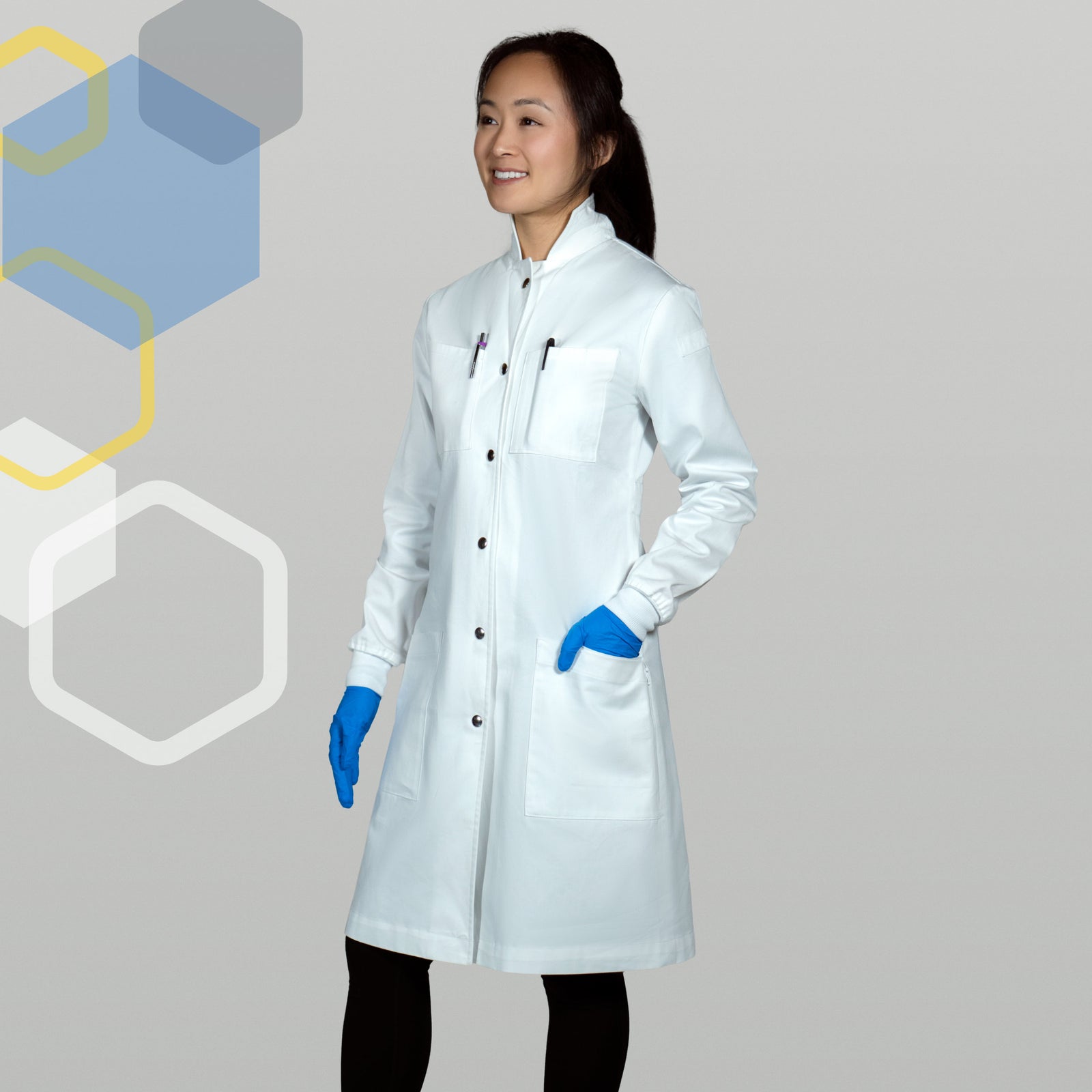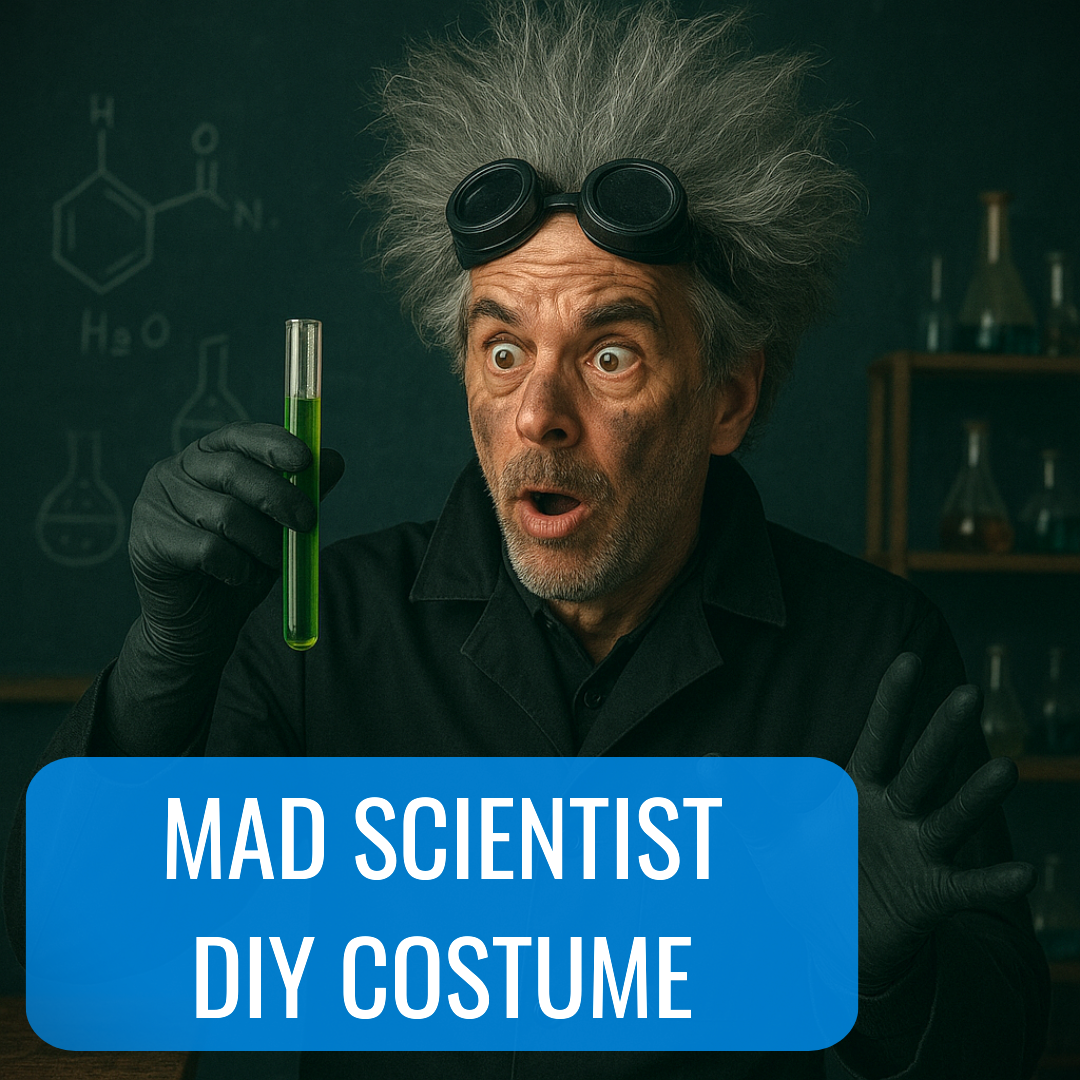Your Cart is Empty
Menu

Lab Coat Materials Ultimate Guide (2025 edition)
15 min read

Table of Contents
- 1. 100% Cotton Lab Coats
- 2. 100% Polyester Lab Coats
- 3. Cotton lab coats treated with flame retardant coating
- 4. Polyester/Cotton Blend Lab Coats
- 5. Nomex Lab Coats
- 6. Nomex IIIA Lab Coats
- 7. Polypropylene Lab Coats
- 8. Nylon blend Lab Coats
- 9. Modacrylic Lab Coat Blends
- 10. Rayon Lab Coat Blends
- 11. Tyvek Lab Coats
- 12. ESD/Anti-Static conductive lab coats
- Lab Coat Fabric Weight Guidelines
- What is the difference between Flame Resistant (FR) and Flame Retardant Lab Coats?
- How to Clean and Wash Lab Coats in Research
- • Best practices for washing your lab coat
- • Chemical lab coat handling: Cleaning and Disposal
- • Biological lab coat handling: Cleaning and Disposal
- • Instructions for autoclaving lab coats
- • Radiation hazard lab coat handling: Cleaning and Disposal
- • References
- Frequently Asked Questions (FAQs):
- • What are lab coats made of?
- • Do lab coats have to be 100 percent cotton?
- • Are cotton lab coats flammable?
- • How often should you wash your lab coat?
- • How do I choose a lab coat?
- Help us design a better lab coat for scientists and engineers
Last updated: February 2nd, 2025
Should you use 100% cotton or a polycotton blend? When do you need fire resistance? What does flame retardant mean? We’re here to help you find exactly what you need in all of these confusing options!
Your type of research will determine what lab coat is best for you. Healthcare professionals and researchers working with hazardous materials shouldn’t wear the same lab coat. Fire resistance often comes at a cost of chemical resistance and vice versa. So…
Which lab coat material is right for you?
The fabric you choose makes all the difference. This simple guide walks you through the most common fabrics used for lab coats, how to choose the correct lab coat fabric, and how to clean each type of lab coat.
100% Cotton Lab Coats
Cotton lab coats (like these) are incredibly comfy, lightweight, and long-lasting. It's the preferred material for lab coats by many scientists and is often required for college chemistry lab. Cotton is a breathable fabric, although it is frequently combined with polyester since it wrinkles readily. It may also come with fire-resistant (FR) coatings, however, industrial laundering and acids can degrade this coating. It sometimes has a stain-release finish, but this can also deteriorate over time.
Cotton lab coats are somewhat solvent-resistant but susceptible to acid spills so barrier layers like long butyl gloves should be worn with these coats when handling strong acids. High-quality lab coats are often 100% cotton and are usually more expensive than poly-cotton blends. Cotton can be mixed with other fibers for wrinkle-resistance and flexibility while maintaining its FR rating, like the 88% cotton/12% nylon blend commonly used.
✅Pros: Good for freshman chemistry lab, clinical settings, and research laboratories where there is some work with flammables, heat, and flame, and where splash resistance to acids is not a concern. Usually the most comfortable fabric.
❌Cons: When working with corrosive materials like acids, cotton lab coats should be accompanied by a chemical splash apron and long acid-resistant gloves to cover arms. Cotton may also shrink if laundered at high temperatures.

Here is a short video showing a durable cotton lab coat versus others blended with synthetics:
100% Polyester Lab Coats
Polyester is a synthetic material that is basically a weave of plastic fibers. Polyester is robust and long-lasting. It’s easier to care for and dries considerably faster than cotton, and it also provides a good “barrier” to acids and biological contaminants because it does not absorb liquids. It's also less expensive to manufacture than cotton. This makes it commonly used for biomedical research and blood testing labs.
However, polyester is a huge safety hazard when working around heat or flames like Bunsen burners or hot plates. Polyester should not be used in environments with pyrophoric chemicals, open flames, or any flammable risks, as it burns easily and melts to your skin, inflicting serious skin burns while trapping you inside.
✅Pros: It’s suitable for biomedical laboratories where biological pathogens and diseases are present. It's inexpensive, doesn't shrink, and keeps contaminants on the outer surface.
❌Cons: Uncomfortable, scratchy and stiff. Melts easily and should not be used around heat sources or where combustible solvents are present.

Cotton lab coats treated with flame retardant coating
The chemical treatment given to these fabrics in the factory gives them their flame retardant properties, not the inherent properties of the fiber. This chemical treatment soaks through the fiber and binds it throughout the fabric. The fabric becomes flame retardant and maintains that property throughout the garment's lifetime unless you break the manufacturer's recommended washing conditions which can include using high-temperature water or bleach during laundering.
Cheaper FR-treated materials wear down quickly when washing, but some more advanced brands like Westex say that their FR treatment will remain effective for the lifetime of the garment. These materials have similar properties and performance to 100% cotton plus the enhanced resistance to flames.
✅Pros: For labs with a fire concern, this is preferable to poly/cotton. Somewhat solvent-resistant.
❌Cons: Not fluid resistant; especially susceptible to acids.

Polyester/Cotton Blend Lab Coats
Most cheaper lab coats (<$30) are made of a polyester and cotton blend. It's breathable, light, and simple to wash, with moderate splash and chemical protection (though this is dependent on the manufacturer). Polyester-cotton blends with at least 35% cotton are appropriate for usage in an atmosphere without open flames, albeit they are not as soft and breathable as 100% cotton. They are good for doctors, pharmacists, and clinical settings but are typically not allowed in college chemistry lab courses because of the open flames.
| Poly/Cotton Blend | Chemical Properties | Flame Resistance | Durability |
| 80/20 Poly/Cotton Blend | Higher polyester content makes it suitable for working with chemicals or biological materials | Higher polyester content is NOT suitable when working with flammable powders or solvents | Higher polyester content makes it more durable and easy to launder |
| 65/35 Poly/Cotton Blend |
A minimum of 65% polyester gives good protection against acids |
Not flame resistant but can be used when there are no open flames, hot plates, or strong oxidizers | Less durable than 80/20 blend, still wrinkle-resistant |
| 40/60 Poly/Cotton Blend |
Not recommended when working with acids |
Not flame resistant but can be used for an environment where there are no open flames, hot plates, or strong oxidizers | Low polyester decreases durability |
✅Pros: Appropriate for use in clinical settings and research laboratories that handle biological materials without heat or flame. Durable and inexpensive.
❌Cons: It melts easily to your skin and is not considered appropriate for working with flammable materials, open flames, or near high heat sources. Typically not as comfortable or breathable as 100% cotton.
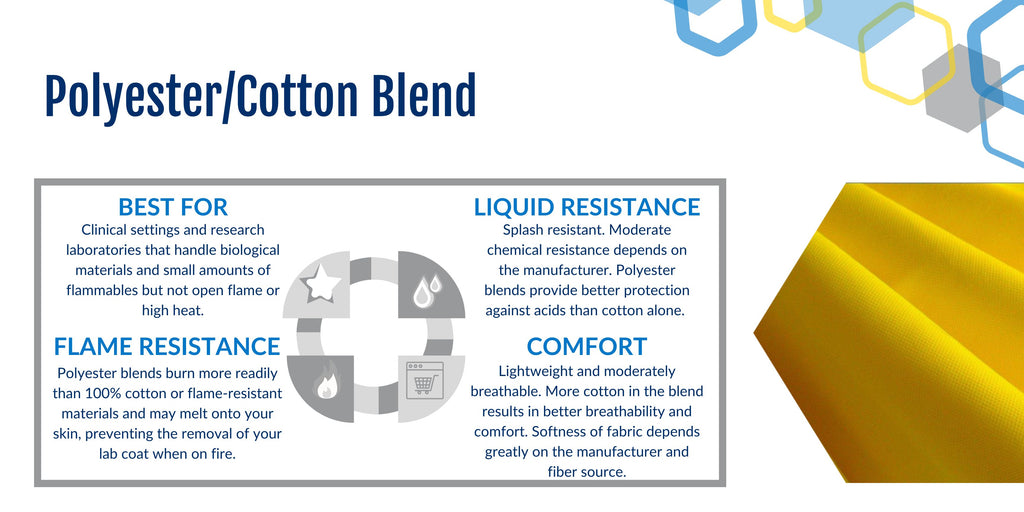
Nomex Lab Coats
Nomex is one of the more expensive options on this list, but it's ideal for environments with significant fire hazards, open flames, electric arc hazards, or pyrophoric compounds. It is difficult to ignite and acts as a fire and heat barrier. Because the fibers are inherently flame resistant, not just coated, the flame resistance is retained in industrial laundering as long as bleach is not used. Most FR clothing for firefighters and stunt doubles are made from Nomex.
✅Pros: It's tough, flexible, and tear-resistant, as well as resistant to most chemicals. Appropriate for use in research facilities where open flame and pyrophoric substances are common and pose a serious fire risk.
❌Cons: When exposed to chlorine bleach, Nomex decomposes. Susceptible to non-polar organic solvents like acetone. Most lab coats made of Nomex are over $120. Style and color options with Nomex are extremely limited.

Nomex IIIA Lab Coats
The Nomex IIIA interlock knitting fabric is made up of 93%Nomex, 5% Kevlar, and 2% P-140. In the event of a fire, Nomex IIIA is a flame-resistant, high-temperature-resistant fiber that does not melt or drip. You’ll often see this marketed as “Shield CXP” which gives the rare combination of FR and CP (Chemical Protection).
The capacity of Nomex to carbonize and thicken when subjected to severe heat is a major factor in the protection it provides. This common reaction strengthens the barrier between the heat source and the wearer's skin, reducing burn injuries.
When exposed to heat and flame, the 5% Kevlar adds extra strength and structural integrity. Electrostatic discharge (ESD) protection comes from the 2% P-140 electrically conductive fibers. Nomex IIIA also has better chemical resistance than regular Nomex.
✅Pros: The flame-resistant protection of Nomex IIIA fabric cannot be washed out or worn away, unlike flame-retardant treatment applied to the surface of cotton or cotton blends. This is the most protective material currently on the market.
❌Cons: Lab coats made of Nomex IIIA are usually over $200 and have limited color and style options. The chemical resistance may deteriorate if laundered with bleach. Susceptible to non-polar solvents like acetone.

Polypropylene Lab Coats
Most disposable lab coats are made of a heavy polypropylene weave. It's actually light and breathable, with high resistance to moisture absorption providing great “barrier” protection to biological materials and dust mitigation in clean rooms. Carbon fibers are sometimes added to polypropylene lab coats to improve their antistatic (ESD) properties. If you work in a biohazard lab or semiconductor fab, you may need to wear a disposable lab coat that is made from polypropylene.
✅Pros: Best in biomedical laboratories where pathogens and cross-contamination are a concern. It’s a short-term use item that is also inexpensive.
❌Cons: When exposed to UV light, it swiftly degrades and is extremely combustible near flames. They also tear easily at the seams and pockets.
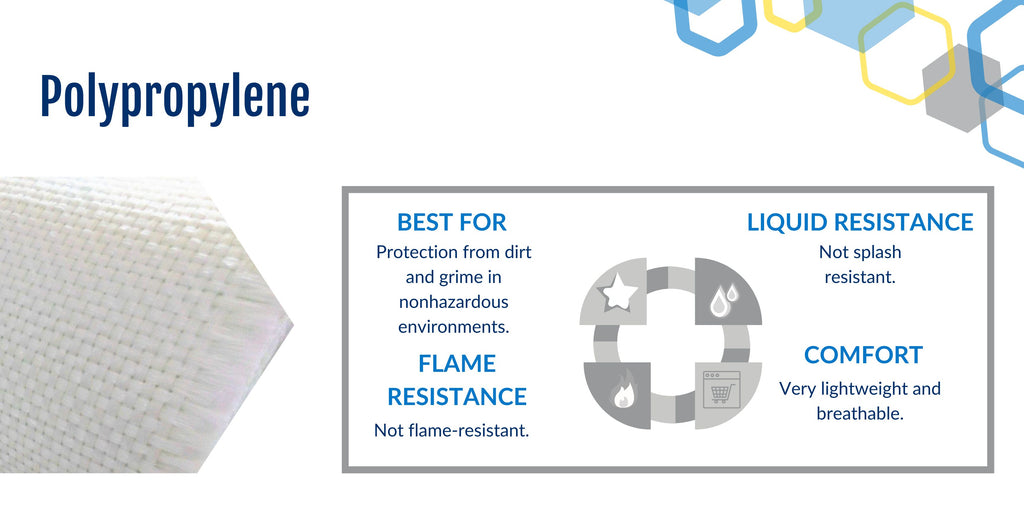
Nylon blend Lab Coats
Nylon is a petrochemical-based synthetic fiber. It is recognized for its excellent softness, strength, and durability. Nylon is easy to dye and it is available in a wide range of colors. Because nylon melts easily when exposed to fire, it needs to be woven in small fractions with flame-resistant materials.
Nylon is not usually used by itself to make lab coats. Cotton/nylon blends such as "88/12", the most common can give better wrinkle resistance, stretch and durability than 100% cotton. Some 88/12 blends are FR-rated, but the FR performance varies by manufacturer.
✅Pros: Lightweight and strong. It’s also wrinkle-resistant and easy to launder.
❌Cons: Cannot be used in high concentrations while maintaining flame resistance. 12% nylon in cotton can be FR rated if the fabric is treated by the manufacturer.
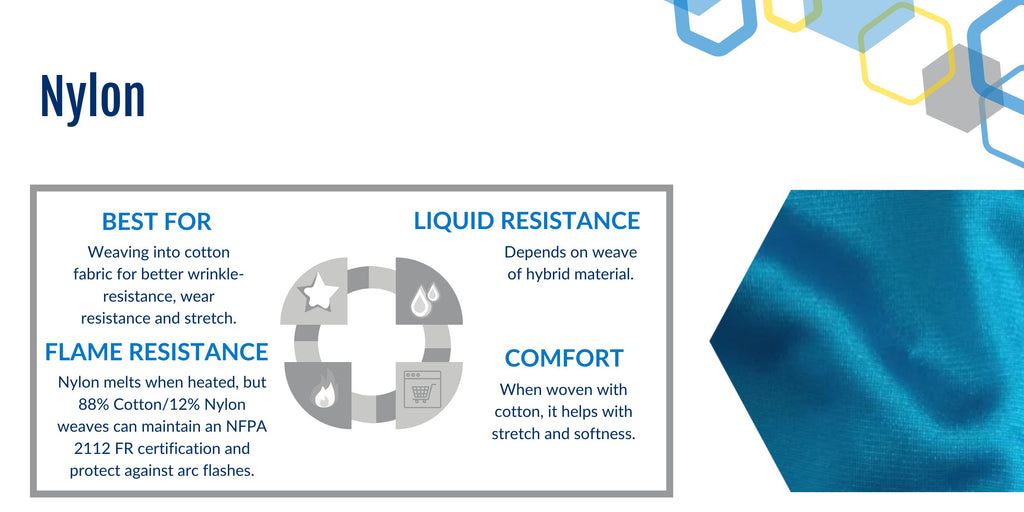
Modacrylic Lab Coat Blends
Modacrylics are a type of synthetic copolymer. One of the benefits of the Modacrylic lab coat is that it is exceptionally resistant to rips and tears, as well as having great wrinkle resistance. Modacrylic is a soft, durable, and pleasant fabric that is also easy to care for. It's often used as a blend with other fibers like Lyocell and Aramids in the Westex DH fabric, which is FR and arc-flash rated. This material is only advised when your safety officer specifically recommends it for your work environment.
✅Pros: It's fire-resistant, resistant to chemicals and solvents, rip- and tear-resistant, and doesn't wrinkle easily.
❌Cons: It is heat-sensitive and should not be steamed or washed at high temperature.
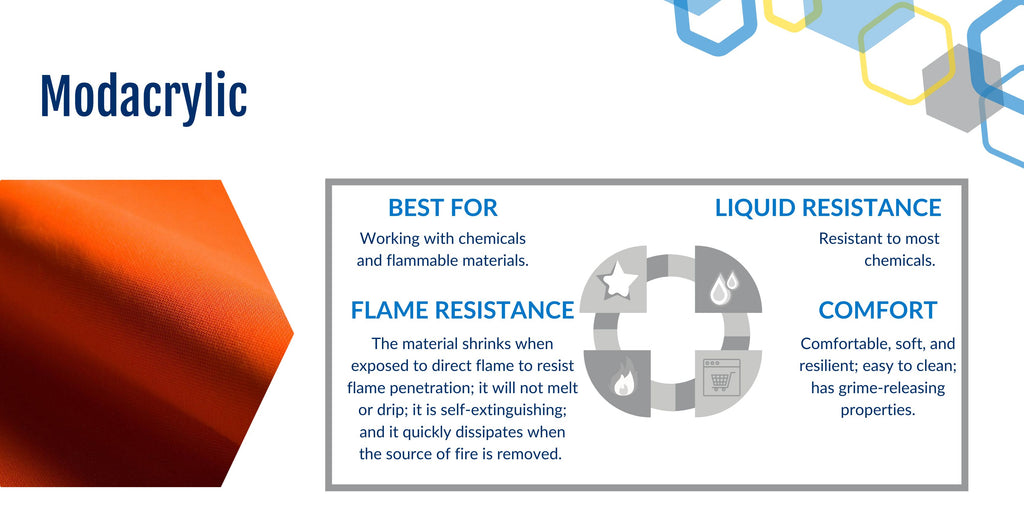
Rayon Lab Coat Blends
Rayon is a fabric manufactured from purified cellulose fibers, usually extracted from wood pulp. It's less expensive than cotton, but it has similar properties such as being breathable, lightweight, and absorbent, making it a popular choice for manufacturers trying to add some comfort to their low-cost polyester lab coats.
It's common to have blends of around 50% polyester, 45% Rayon and a few percent Spandex for a very breathable, stretchy and wrinkle-free lab coat. However, Rayon is easily degraded by acids and is only recommended in light-use environments where chemical and fire hazards are not present. These should normally not be used in non-clinical research environments.
✅Pros: It’s cheap and fairly durable.
❌Cons: It’s not great against acids or liquids and catches fire easily.
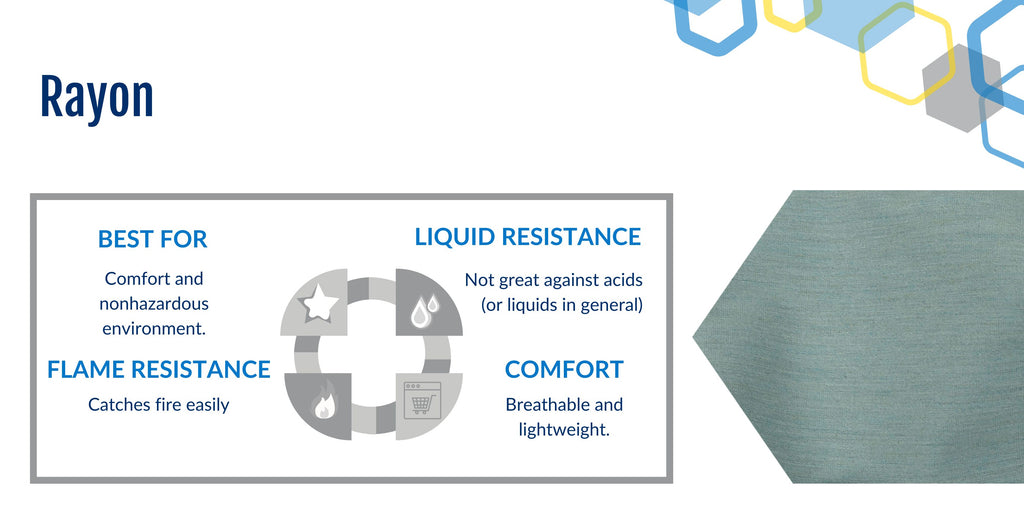
Tyvek Lab Coats
Rather than a fabric type, Tyvek refers to a brand. Tyvek garments are made of flash spun high-density polyethylene, a nonwoven material that is exclusive to DuPont. You may have felt it before if you've ever come across those fibrous tear-resistant off-white large envelopes or seen a pro painting crew in white jumpsuits.
It provides an ideal balance of protection, durability, and comfort. It’s commonly used for special applications that require total impermeability of dust and dirt particles. Many professionals use this type of coverall when dealing with substances such as asbestos, lead dust, spray paint, and radioactive substances.
✅Pros: Extremely durable, rip and tear-resistant. Great for protecting against airborne biological and radioactive material.
❌Cons: It's not a good idea to use it in places where there's a high risk of fire. Not as comfortable or breathable as cotton lab coats.
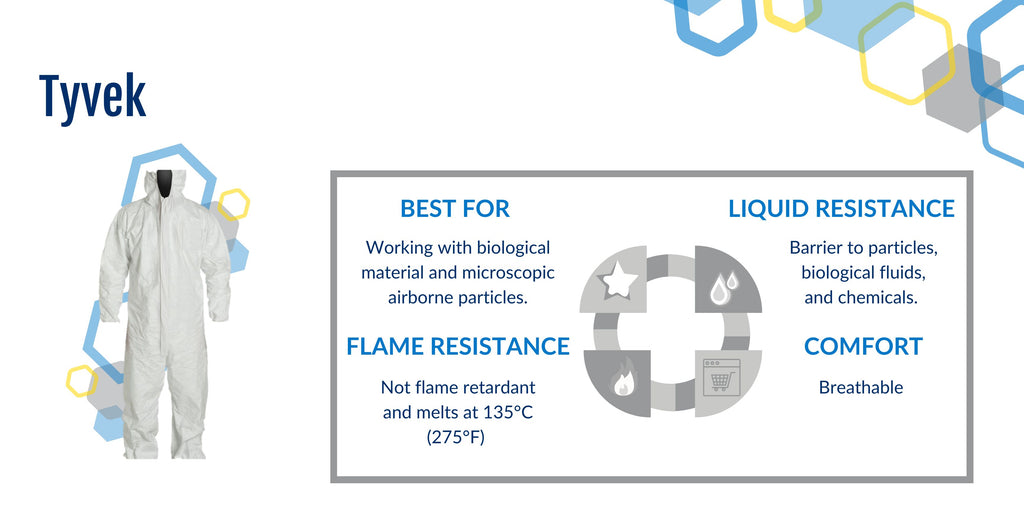
ESD/Anti-Static conductive lab coats
ESD/anti-static lab coats prevent electrostatic discharge and keep the wearer safe in static-prone areas. Anti-static lab coats are used in a variety of settings, including technology manufacturing, explosive environments, fire control, and electrical work. Typically, it's constructed of a poly-cotton blend with a few percent by weight of conductive fibers aligned vertically to “ground” the wearer. ESD lab coats can be made of many materials with widely varying properties.
✅Pros: Prevent electrostatic discharge. Provide a good barrier against water-based liquids, dust particles, and are resistant to light chemical splash.
❌Cons: Usually no flame resistance. Often ESD protection is an unnecessary feature that adds cost.
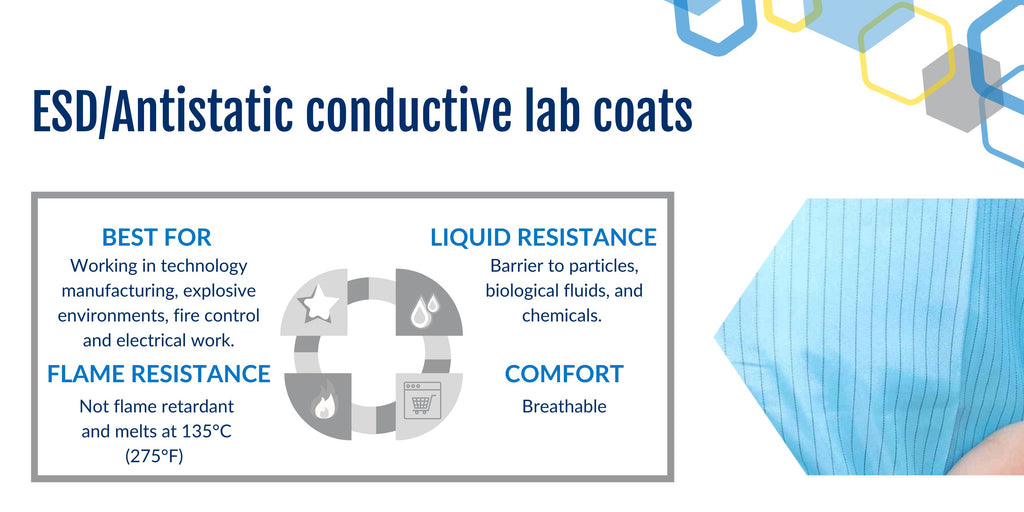
Lab Coat Fabric Weight Guidelines
Do you ever see words like "7 oz cotton" or "142 gsm Nomex" when choosing a lab coat? These are the fabric weights, which refer to what a square yard of fabric would weigh (in ounces) or a square meter would way (in grams for "gsm"). You can convert between these, but for reference, 5 oz is 142 gsm and 7 oz is 198 gsm.
So what fabric weight is good for a lab coat? Consider the breathability of the fabric, the temperatures you're working in and whether or not you're worried about puncturing or tearing.
- 5 oz or less would be considered "light weight" for lab coats
- 6-7 oz is usually comfortable if it's cotton, and is medium weight
- 8-10 oz would be considered heavy-duty for a lab coat
Also make sure you don't confuse the fabric weight with chemical or fire protection. It really isn't correlated. You'll need to check the stats on the lab coat from the manufacturer to understand the safety limitations of each material. For example, a 4.5 oz Nomex IIIA lab coat gives much better protection than a 10 oz cotton/poly blend.
What is the difference between Flame Resistant (FR) and Flame Retardant Lab Coats?
Flame resistant (FR) lab coats are made from materials that are intrinsically non-flammable like Nomex, while flame-retardant lab coats are made from materials that can normally catch fire but are chemically treated in production to burn slowly or self-extinguish, like cotton.
The “FR” acronym typically applies to Flame Resistance, also known as Fire Resistance, which is normally preferred over Flame Retardant materials. However, some textile manufacturers like Westex have data showing that their FR treatment process is so good, it doesn't degrade during washing if the right laundering conditions are used.
FR lab coats should use “NFPA 2112” certified materials, which will be noted on the tag. This is a minimum performance specification by the National Fire Protection Association that helps standardize claims of FR protection across various materials and designs. In many labs, FR lab coats are a different color to avoid mix-ups and improve compliance.
Both fabrics and specific lab coats can be “FR” rated and need to be certified individually with several flammability tests. Although FR fabric generally gives a lab coat good protection, design flaws such as large vents or melting fasteners could negate the performance of the fabric.
The NFPA 2112 certification is a pass/fail test, with the passing criteria including less than 50% body burn in a simulated manikin burn test. Some “FR” lab coats may pass with 40% body burn while the very best materials may pass with only 10% body burn. Check the manufacturer’s NFPA 2112 testing certificate for this “body burn” report if this level of detail is important for your job function. Remember, these materials are simply meant to not make the fire worse (like polyester would). They don’t give 100% protection in serious fires.
If you use a Flame Resistant or Flame Retardant lab coat, you must be very careful to launder them within the conditions set by the manufacturer. Common treatments like bleach and very high temperature water can reduce the performance and put you at risk. Spilling acids on your coat can also locally degrade the FR protection.
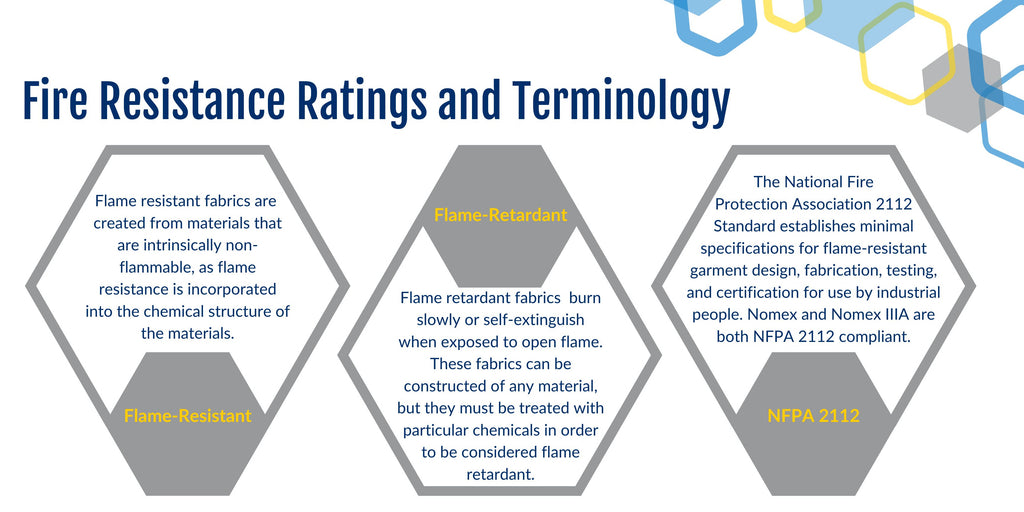
How to Clean and Wash Lab Coats in Research
When was the last time your lab coat was washed? Never?! Most lab coats should be washed regularly to remove chemical and biological residue that could harm you or contaminate your experiments.

If you’re used to throwing all of your laundry in a single load on hot, don’t do that here! You can ruin a great lab coat by washing it the wrong way. Bleach is incompatible with Nomex® and Fire Resistant lab coats. If available, use a dedicated on-site facility or off-site contractor who has been trained in potential hazards and washing conditions.
A weekly wash schedule is recommended for heavy use; washing should be monthly at worst for less regular use. Always wash or discard lab coats immediately after significant spills.
If your institution does not have professional laundering available, lab coats should be double-bagged for home transportation and cleaned separately from normal clothes. Never home-wash lab coats that could have contamination from carcinogens, biologically-harmful chemicals, dangerous pathogens, or corrosive chemicals.
Best practices for washing your lab coat:
- Unbutton all buttons, but zip all zippers before washing. Empty pockets!
- Check your lab coat tag and the manufacturer’s website for washing recommendations.
- The hottest water setting is often necessary for good cleaning, but can also ruin some lab coat materials.
- Never use bleach on lab coats unless the tag specifically says it’s OK. Bleaching an FR lab coat could reduce the fire resistance and allow burns when you think you’re protected.
- Dry according to the directions on the tag.
- Run the machine empty with bleach on hot to disinfect and clean the washing machine of any residual contaminants.
Chemical lab coat handling: Cleaning and Disposal
If a significant chemical spill occurs on clothes, or if the spilled substance is particularly toxic, corrosive, or persistent (non-evaporating), the lab coat must be disposed of according to hazardous waste disposal standards and will not be accepted for washing.
Contaminated lab coats should be thrown away and should not be washed if they have been contaminated by:
- Corrosives or strong acids
- Materials that can flow through Nitrile gloves (for example, organometallics such as methyl mercury); or
- More than 250 milliliters of:
- Carcinogens
- Teratogens
- Toxic substances with an LD50 of 50 mg/kg.
A coat can be professionally washed and reused if the spill does not meet any of the above conditions.
Biological lab coat handling: Cleaning and Disposal
- For BSL-1 work, autoclaving before washing is recommended but not always necessary if there were no known contaminations or spills. Check with your institution.
- For BSL-2 work, autoclaving is required before washing your lab coat.
- If a known or suspected biological agent contamination/spill occurs all lab coats should be autoclaved (regardless of risk group assessment level or biosafety lab level).
- Biologically contaminated lab coats that are also contaminated with chemical or radioactive substances should not be autoclaved. This can cause dangerous chemical reactions or explosions.
Instructions for autoclaving lab coats:
- Check with the manufacturer that the lab coat is autoclavable.
- Collect lab coats in a lidded container with a Biohazard label, lined with an autoclave bag and labeled with contents and date.
- Autoclave in a clear bag or well-labeled opaque bag. You don't want anyone to mistake this bag for waste!
- Decontaminate the lab coats on a solid or pre-vac cycle in the autoclave. Use a Chemical Integrator (CI) for load verification.
- After the autoclave, lab coats should be laundered by a professional service whenever possible.
Radiation hazard lab coat handling: Cleaning and Disposal
If a spill on the lab coat contains radioactive material, immediately notify EHS and/or Facilities Management. The lab coat will be sealed and disposed of as radioactive waste in a sealed bag.
References
MIT Lab Coats selection, use, and care
OHS Online: Do’s and Don’ts of lab coats
Columbia University Lab Coat information table
Virginia Tech PPE Use Guidelines
Guidelines for Selection, Use, and Care of Laboratory Coats (Univ. of Akron)
The Lab Coat Project - 100% Cotton Lab Coat for Scientists
We were a little frustrated with all the "doctor"- focused options out there, so after gathering feedback from over 1500 scientists, we designed, tested, and are launching our own.
With strong metal snaps, long knit cuffs, a convertible up/down collar, more pockets than any other lab coat and even an adjustable belt to give you some shape, we really think this is going to be the best lab coat for general chemistry lab classes ever made.
After 2 years of development and testing, these are now in stock and ready to ship. Visit The Lab Coat Project page here to see more details, or check our Amazon Store Page if that's easier for you!

Frequently Asked Questions (FAQs):
What are lab coats made of?
The most common materials are cotton and cotton/polyester blends. Cotton can be FR treated for better flame resistance. The best (and most expensive) material is Nomex IIIA, used by chemists around very dangerous chemicals. Other jobs require lab coats made out of polypropylene or Tyvek.
Do lab coats have to be 100 percent cotton?
Lab leaders will recommend 100% cotton lab coats when working around open flames like a Bunsen burner. Cotton burns more slowly and will not melt to your skin like polyester. However, other fabrics like Nomex, Nomex IIIA or FR-treated cotton blends can be substituted for 100% cotton if it has a NFPA 2112 fire-resistant certification.
Are cotton lab coats flammable?
A 100% cotton lab coat will still catch fire, unless it is treated with FR chemicals in production. However, cotton is preferred over polyester when working around open flames and heat sources. Always check the tags for NFPA 2112 certifications if flame resistance is important in your work.
How often should you wash your lab coat?
Wash lab coats weekly if using for several hours a day. Wash at least once per month for less frequent use. Refer to our washing guide above for care instructions by material and field of work.
How do I choose a lab coat?
Start by identifying the fabric you need based on the hazards in your workplace. This guide will help. If you deal with chemical and fire hazards, you want a closed collar, knit cuffs and snaps for quick removal. With those elements fixed, look for the best fit that will ensure you love wearing it every day.
If you need some more help, you can check out our list of best lab coats for scientists, sorted by field and updated annually.
Author
Lab Coat Guides
Stay up to date
Drop your email to receive new product launches, subscriber-only discounts and helpful new STEM resources.
Disclosure
As an Amazon Associate I earn from qualifying purchases.
Lab Coats designed by scientists
Our lab coats were designed from the feedback of over 1000 scientists as a part of The Lab Coat Project. It's a crowdsourced design specifically for scientific research, especially general chemistry, organic chemistry and microbiology labs, with high-end features at an affordable price.

The Ultimate Lab Coat Guide: 5 Types Every Scientist Should Know
5 min read
After spending three years researching lab coats and surveying over 1,500 scientists in what I call "The Lab Coat Project," I've discovered something troubling: most of us are wearing the wrong lab coat. Let me break down the five major classes of lab coats you'll encounter, so you can make an informed decision that keeps you safe and comfortable in the lab.

Do Lab Coats Have to Be White?
4 min read
Ever wondered why lab coats are white? Discover the surprising history behind the iconic garment and why today’s scientists might wear more than just white in the lab.
GET UPDATES ON NEW LAB COAT DESIGNS
Drop your email to be notified when new lab coat designs are released, plus our monthly resource newsletter.
